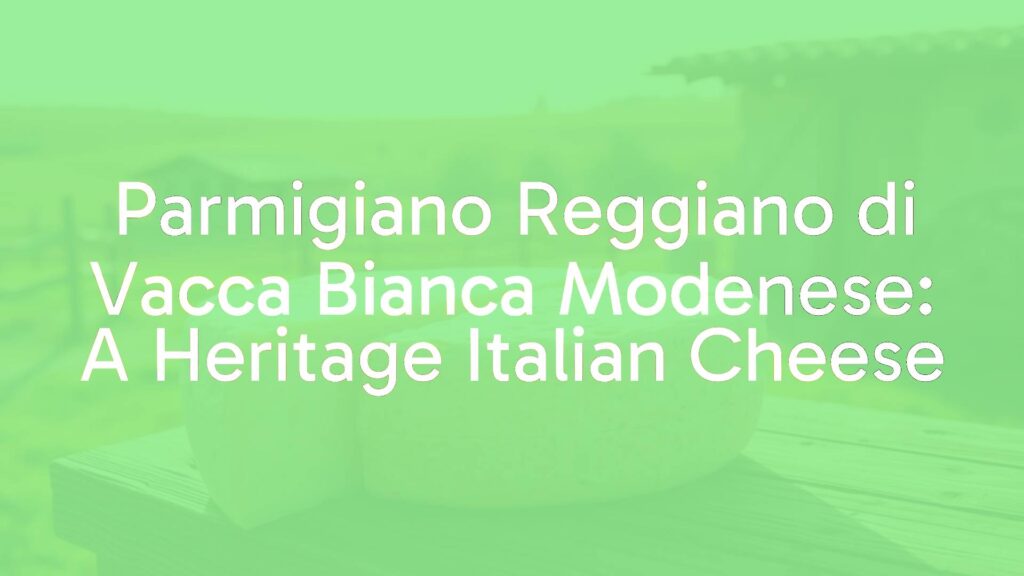An Introduction to Parmigiano Reggiano di Vacca Bianca Modenese
Parmigiano Reggiano di Vacca Bianca Modenese is a remarkable and rare variant of the world-renowned Parmigiano Reggiano cheese, crafted exclusively from the milk of the Modenese White Cow—an ancient and endangered cattle breed native to the Emilia-Romagna region. Prized for its unique qualities and deep-rooted connection to Italian history, this cheese embodies the diversity and richness of Italy’s artisanal food heritage.
Origins and Historical Context
The Modenese White Cow, known locally as “Vacca Bianca Modenese”, has grazed the lands of Modena and its surroundings since at least the Middle Ages. Once widespread, the breed faced a dramatic decline post-World War II due to industrialization and the introduction of higher-yielding cow breeds. However, passionate farmers and cheese makers have worked tirelessly to preserve both the cattle and the unique cheese made from their rich, flavorful milk. This cheese is produced in very limited quantities and represents a piece of living history, carrying forward centuries-old practices and local traditions.
Key Characteristics
Parmigiano Reggiano di Vacca Bianca Modenese distinguishes itself with a richer, more nuanced flavor profile than more common Parmigiano types. The cheese bears an ivory-to-pale-yellow paste, known for its fine but flaky texture and a remarkable balance between savory, nutty, and subtly sweet notes. Thanks to the creamy, protein-rich milk of the Modenese White Cow, the cheese develops deep aromas and a persistent, complex finish, often described as more delicate and elegant compared to standard varieties.
Production Methods
This artisanal cheese is made following strict disciplinary guidelines for Parmigiano Reggiano, but with particular attention to the characteristics of the Modenese White Cow milk. The cows graze mainly on local grasses and forage, imparting unique flora to the milk. Production involves raw milk, natural whey starter, and calf rennet, with no additives. The lengthy aging—often 24 to 36 months or more—enables the cheese to develop its trademark flavor and texture. Each wheel is carefully inspected and branded if it meets the consortium’s exacting standards.
Traditional Enjoyment and Serving Suggestions
Parmigiano Reggiano di Vacca Bianca Modenese is best appreciated in simple preparations that highlight its complexity. Classically, it’s savored in generous shards, accompanied by traditional balsamic vinegar from Modena—another local treasure. The cheese also shines as an elegant table cheese, paired with crusty bread, ripe pears, or apples. Regionally, it may accompany Lambrusco or other lightly sparkling red wines, creating a harmonious balance between cheese and wine.
Cultural and Culinary Significance
This cheese holds a special place in Emilia-Romagna’s identity, symbolizing the efforts to sustain rare breeds and preserve traditional foodways. It is often celebrated during local food festivals and is recognized by Slow Food’s Presidium for its importance in biodiversity and gastronomy. The dedication to artisan production methods and breed conservation has elevated this cheese as a cultural icon, valued by chefs and gourmands not only in Italy but among discerning enthusiasts worldwide.
Pairings and Tips for Enjoyment
To make the most of Parmigiano Reggiano di Vacca Bianca Modenese, allow the cheese to come to room temperature before serving, to fully express its aromas and flavors. Complementary pairings include aged balsamic, honey, walnuts, and fresh figs. For beverages, try Emilia-Romagna’s local reds or a dry, structured white wine. Avoid overpowering flavors that could mask the cheese’s subtle complexities. Its rarity makes each tasting occasion special—ideal for celebrations or as a centerpiece in curated cheese selections.

